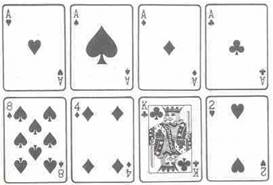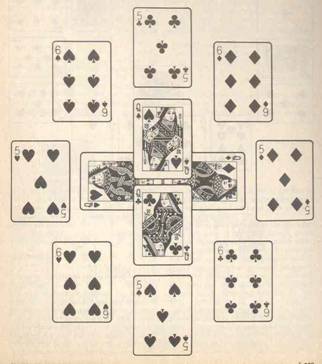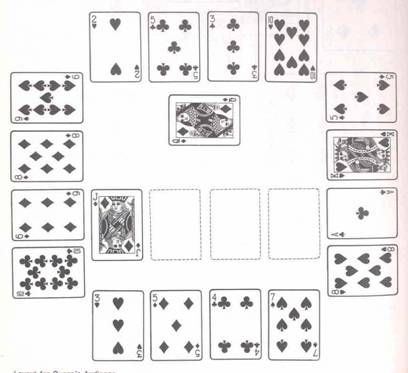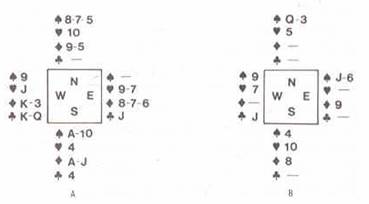Auld Lang Syne
Layout. Remove the four aces from the pack and place them in a row. These foundations are built in sequence up to kings, regardless of suits.
Play. Deal a row of four cards below the foundation, forming the reserve. Top card loo of reserve piles are available for play on foundations. Spaces in the reserve are not filled except by the deal. Continue to deal in groups of four cards, one on each pile or space. Pause between deals to play up what you can.
Sir Tommy
A derivative of Auld Lang Syne, this game is also known as old Patience, Try Again, and Tim O’Shanter. It offers a choice in placing cards from the hand.
Foundations. The four aces, as they become available, are placed in a row and built up to kings, regardless of suits.
Play. Deal four cards, one by one, placing each on any of four waste piles below the foundations. Play up what you can. Continue dealing cards one by one and placing them as desired on the four piles. Pause to play up to the foundations only after each group of four cards has been placed. Top cards of waste piles are available for play on foundations. As many or as few cards may be placed on one pile as desired.

Layout for Auld Lang Syne
Puss in Corner
This card games is so called because the waste piles are traditionally placed outside the corners of the foundations, which are placed in a rectangle.
Foundations. Remove the four aces from the pack and place them in a row. Each is to be built, up to the king in its own color, either red or black.
Play. Follow the rules for the play of Sir Tommy.
Redeal. One redeal is permitted. After the hand is exhausted and play is at a standstill, pick up the four waste piles in the same order they were dealt, turn them face down, and deal again.
Calculation
Calculation stands at the top of the list of games that give opportunity for skill. Some devotees go so far as to say that two games out of three can be won by patience and application. While this may be an exaggeration, certainly the experienced player wins four or five times as often as the beginner.
Foundations. Remove from the pack any ace, deuce, three, and four, regardless of suits. Place these four cards in a row to form the foundations. Each is built up in arithmetical series as follows, without regard to suits:
A, 2, 3,4, 5, 6,7, 8, 9, 10, J, Q, K
2,4,6,8,10, Q, a, 3, 5,7,9, J, K
3, 6, 9, Q, 2, 5, 8, J, A, 4, 7, 10, K
4,8, Q, 3, 7, J, 2, 6, 10, a, 5, 9, K
Play. Turn up cards from the hand singly and place unplayable cards on any of four waste piles below the foundations. These piles should be spread downward so that all cards can be read. The top card of each waste pile, as well as the card in hand, is available for play on foundations.
Four Kings
This is a way of playing Calculation so as to remove most of the choice; hence, most of the opportunity for skill is gone.
Layout. Place in a row any ace, deuce, three, and four, regardless of suits. These are index cards. in a row below them place any deuce, four, six, and eight, regardless of suits. These are foundations. The foundations are built up in arithmetical series. The separate index row serves as a reminder of the arithmetical difference in each series.
Play. Turn up cards singly, placing unplayable cards face up on a single waste pile. The top card of this pile, and the card in hand, are available for play on foundations.
Redeal. Two redeals are permitted.
Quadrille
Foundations. The fives and sixes, as they become available, are moved into a circle. The sixes are built up in suit to jacks; the fives are built down in suit to kings, which come after aces.
The queens, as they become available, are placed in the center of the circle. These cards are dead, and they are used merely to complete the layout picture

Layout for Quadrille.
Play. Turn cards up from the pack singly, placing unplayable cards face up on a single waste pile. The top card of this pile, as well as the card in hand, is available for play on foundation.
Redeal. Two redeals are permitted.
The face-down stock is found in very few poker solitaire, though face-down cards in the tableau are common.
Layout. Count off 13 cards face down, and leave them face down in a pile to form the stock. Deal a row of four cards to left of the stock and four more to the right, forming the wings of the reserve. Deal one card above the stock, as the first foundation.
Foundations. The other three cards of same rank as the first foundation are moved into a row with it, as they become available. The foundations are built up in until each pile is 13 cards.
Play. Reserve cards are available for play on foundations. Each space in the wings must at once be filled by the top card of the stock, turned face up. After 12 cards have been played off the stock, thirteenth may be turned face up, and it then is available for play on a foundation as well as into a space. After the stock is exhausted, reserve spaces may be filled from the hand or the waste pile as the player chooses.
Waste Pile. Turn up cards from the hand one by one, placing unplayable cards face up on a single waste pile. The top of this pile, as well as the card in hand, is available for play on foundations.
Redeals. Two redeals are permitted.

Layout for Queen’s Audience.
Queen’s Audience
Layout. Deal 16 cards in the form of a square. This is the antechamber (reserve). The enclosed area is the audience chamber.
Foundation. The four jocks are moved into the audience chamber as soon as possible, and then built down in suit to deuces. An available jack may be moved in, however, only if the ace of the same suit is also available. The two cards are placed in a pile, jack uppermost, and the ace is thus discarded. The kings and queens are similarly discarded, but they may be removed only in couple of the same suit as they become available. Pile all the kings and queens together in the audience chamber, keeping a queen uppermost.
Play. All cards in the antechamber are available for poker play on foundations. Turn up cards from the hand singly, filling each space in the antechamber at once and placing unplayable cards face up in a single waste pile. The top card of this pile, as well as the card of this pile, as well as the card in hand, is available for play on foundations.
The ace-jack and king-queen couples may be moved into the audience chamber whenever the two cards of a suit are simultaneously available in the antechamber, on top of the waste pile, or from a card turned from the hand.

Layout for Scorpion.
Scorpion
Layout. Deal seven cards in a row, four face down and three face up. Deal two more rows in the same way; then four more rows with all the cards face up. Overlap the rows to form piles of cards spread downward. The 49 cards so dealt make the tableau. Leave the three remaining cards face down, as a reserve.
Play. All building is confined to the tableau, there being no separate foundations. The object of play is to reduce the tableau to four piles; one of each suit, with the cards of each suit in sequence, the king at the bottom of the pile.
On the top card of each pile may be placed the next lower card of the same suit; nothing may be built on an ace. Any card in the tableau, no matter how deeply buried, may be moved to make a build but all the cards above it must be moved with it as a unit.
On clearing a face-down card, turn it face up; it then becomes available. A space made by clearing away an entire pile may be filled only by a king. Any king in sight is available for this purpose, all covering cards games being moved with it as a unit. After play comes to a stands still, deal the three reserve cards, one on the top of the each of the three piles to the farthest left. Then resume play if the game of cards becomes blocked again it is lost.
